OUTLOOK
Well it looks like we are in for some wet weather for the foreseeable future. There are heavy rainfall warnings for Squamish, Vancouver, and the Lower Mainland. It looks like we will be getting 40-50 mm on Saturday and Sunday so this should blow out all the rivers from the Squamish all the way up to the Vedder. Out on the ocean there will be SE winds of 10-20 knots, so if you are heading out on your boat this weekend it will be wet and windy so bring out the rain gear. Once the rivers drop later next week, fishing should be good as this high water will bring lots of fresh fish in and the high dirty water will give the fish a break from the recent angling pressure.
While we are braving the rain here, Matt is in Hawaii enjoying some sunshine and chasing bonefish. He has spent the first few days of his trip chatting up the locals who are fishing for jacks off the beach. Don’t miss next week’s report for the highlights of his trip to Oahu!
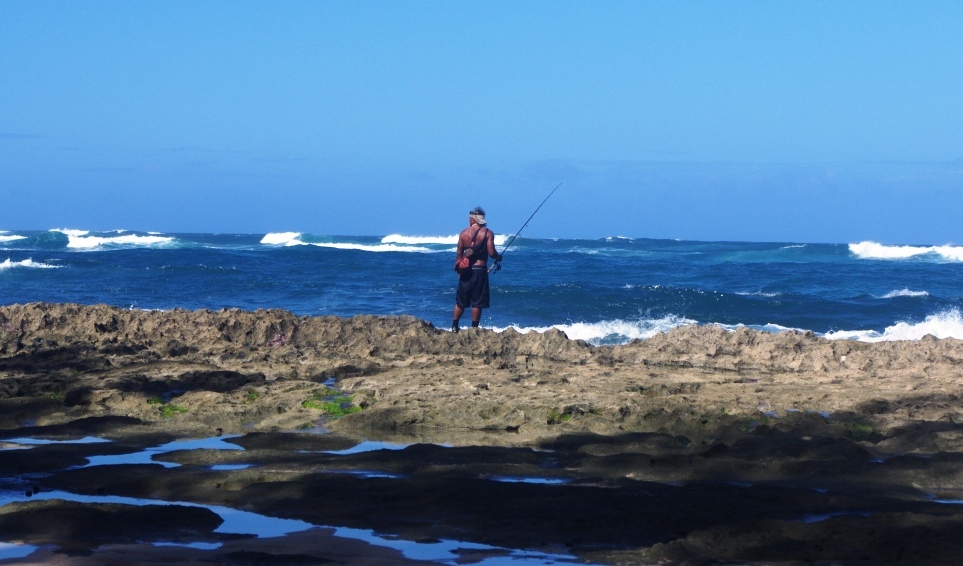
A local beach fishing on Oahu’s fabled North Shore.
COURSES
While the wet start to the month may be hampering efforts to get out on the water you can get your fishing fix in the classroom. We have a great offering of courses throughout February. Brief descriptions of courses offered this month are below with a full listing in the 2015 Course Guide found in the link below. Call the shop at 604.872.2204 to sign up!
Introduction to Fly Fishing
This course was specifically designed to give the new fly fisher the basic knowledge, casting skills and fly fishing strategies to effectively fish our local BC waters. This course is comprised of two sessions; 3hr evening seminar and a 3hr casting session
Cost: $125
Seminar: Wednesday, February 11, 6:30PM to 9:30PM
Casting: Sunday, February 15 either 10:00AM to 1:00PM or 2:00PM to 5:00PM
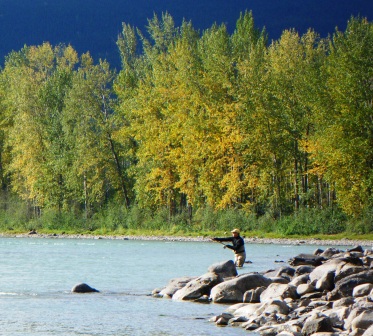
Introduction to Spey Casting
This 2-part course is designed to introduce you to the art of Spey fishing and establish the fundamental techniques required for basic Spey casts used on our local rivers.
Cost: $150 per person
Seminar Date & Time: Tuesday, February 17th / 6:30pm to 9pm
Casting Date & Time: Sunday, February 22nd / 10am to 4pm (Location: Squamish)
Steelhead Float Fishing
Our 3hr evening seminar will educate you on the gear, water types, conditions and other key variables to help you master this fishery. Upgrade your seminar to include a fully guided day on the water, putting into practice your new knowledge with a Pacific Angler guide.
Cost: Seminar $45 per person – upgrade to a walk and wade for $400 for one angler or $500 for two.
Date: Seminar on February 18th – 6:30PM to 9:30PM.
Guided: February 21st , 22nd , or 28th (custom trip dates are available upon request).
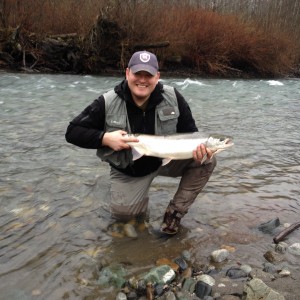
A nice Chilliwack steelhead landed earlier this week.
Tying Intruder Fly Patterns
This course is designed for those that are interested in tying steelhead flies in the “Intruder style”. This style of fly is extremely productive for steelhead and salmon due to its profile and movement in the water.
Cost: $45 per person
Dates: February 23rd and 24th
Time: 7:00pm to 9:30pm
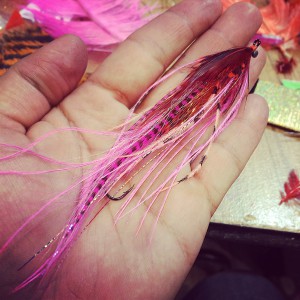
FRESHWATER REPORTS
Chilliwack
It’s hard to believe we are into the first week of February already. With all this warm and wet weather, it hardly feels like a normal winter steelhead season. We have been consistently challenged with high and coloured water. There hasn’t been a cold snap this season yet to clear and let the river drop. As a result, the streambed has shifted multiple times in quite a few places thanks to the heavy flows, making for a constant stream of new pieces of holding water to explore. The high water events have allowed the fish an easy pass for migration. They have been zipping through the river and are thoroughly spread out throughout the entire system. Whatever part of the river you fancy has fish in it at this time.
Fishing pressure has been on the heavier side with the added success that people are experiencing, but its still early in the year there are a lot more fish to come. The fish are on the move and no matter how many guys, or who is fishing in front of you, there is a likely chance you will pick up fish behind them. The key is to move, fish fast and cover water. Standing in one place, or one run for a significant amount of time only closes the door for success. The fish are on the move and so you should be too. Think of where their next holding spot will be as you work your way down the river. In a matter of a few casts, a day can go from zero to hero.
Fly fishermen this year have definitely been getting their fair share of fish. Concentrating on shallow riffles and tailouts 2-5ft deep, where a moving steelhead is likely to rest before it continues its upstream migration is your best bet. These pieces of water provide nice easy swings, short casts, don’t require heavy tips or heavy flies and very little line management. They were built by the fish gods to easily swing a fly. With the warmer weather, and warmer water temps, combined with the higher, coloured water you have the makings for some of the best conditions to target winter steelhead with a fly. Fly selection can vary from angler to angler, but generally speaking lightly weighted or unweighted flies; 2-4” in length in a variety of dark and bright colours is a good start. Flies like the marabou popsicles, egg sucking leeches, string leeches, and intruders are all proven patterns. Attached to a 3 foot piece of 12lb or 15lb maxima tippet on a 10-15ft sinktip and you are more than ready.
On the conventional side of things, everyone has their favourite setup & lure or bait. It has been tough to put away the bigger gear and brighter baits as the big gear allows you to control the fish a lot better in the high water. A large fresh steelhead with the current behind it can snap light line like it was dental floss. Baits such as died prawns, roe and ghost shrimp, all have lots of scent and profile and are a standard producers in high water. Artificials like gooey bobs, large single eggs, pink worms and spin n glos are great either on their own or in combination with bait. Fished on short leaders (12-18”) of 12 or 15lb test and matched with a quality 1/0-3/0 hook and you are prepared for the big one. Traveling steelhead choose the path of least resistance and many times in the high water this is close to the bank. This being the case there is no need to wade deep, or cast to the middle of the river. Another good tip is to keep your gear up off the bottom thereby giving the fish the best chance to see your presentation.
As for a prediction for the up coming conditions, we are expecting more rain in the next couple days, so its safe to say look out for changes in your favourite spots and high coloured waters. Hopefully things drop down mid week and there are some good holding spots full of fresh steelhead.
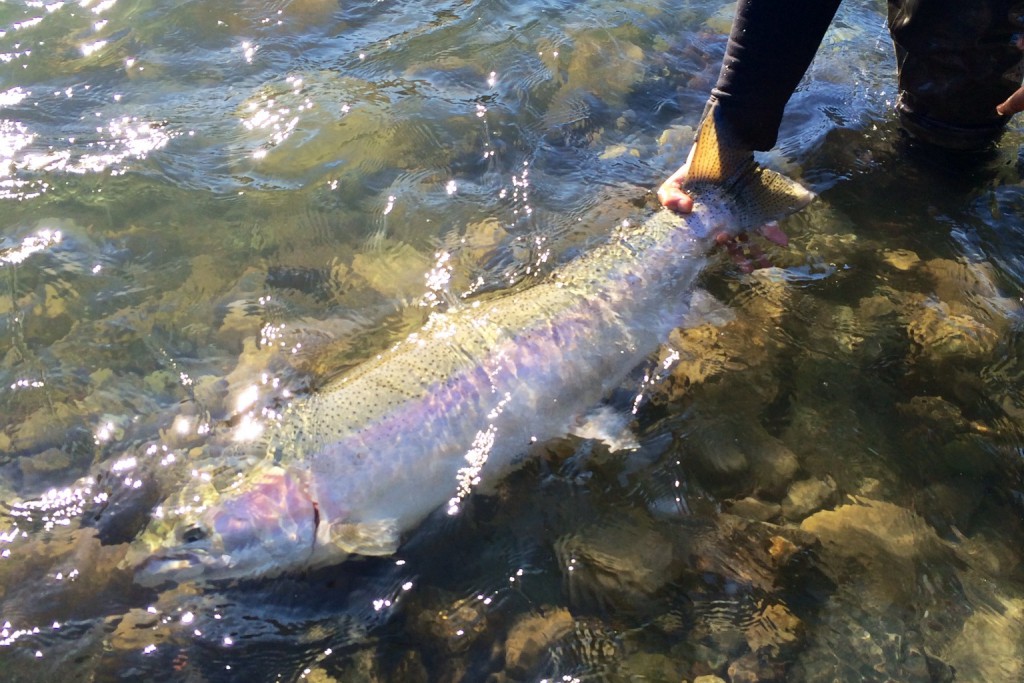
A nice winter steelhead from the Vedder.
Squamish
Here we go again. I’ve been checking the weather reports and it looks like we will be blown out for the weekend. Too bad I will be in Hawaii to miss it. (Sorry couldn’t help myself)
The good news is the fishing should be awesome when the water comes down. We had an interesting day last weekend after the rain that is worth reporting and might help your strategy after this rain event. We fished the morning in my usual spots and fishing was slow. In the afternoon we hit a spot that I have not fished in years and low and behold it was stacked with fish. We fished it with a streamer and got a couple but the second we put on the pail egg, things started happening. In reports earlier this month I outlined some thoughts on why egg fishing was slow this winter; musing that all the high water events we have experienced had pushed eggs out of the river. Our success this past weekend challenged those thoughts. It could mean the area we were fishing hadn’t been affected by high water and eggs are still in that section of river or it could have just been dumb luck. Long story short after this next big push of water if your regular spots have changed a bunch and are not working don’t be scared to change it up. A five minute drive could be the difference between feast or famine. Good Luck!
Squamish is 100% catch release barbless fishery so play by the rules, respect your fellow angler.
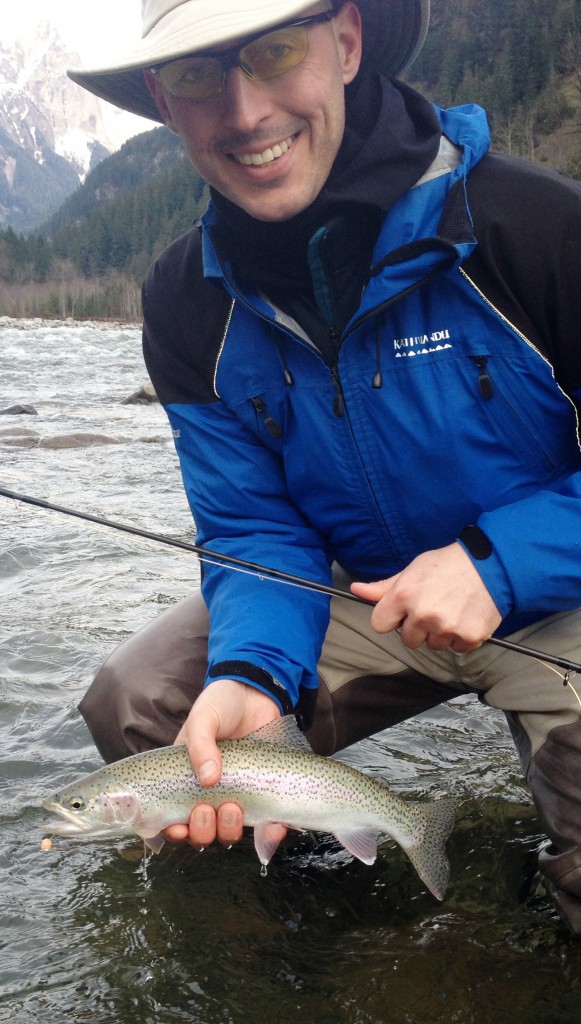
Squamish Rainbow caught on a pale egg.
Matt Sharp
Chehalis
We are about to get another bump of rain and fingers crossed a bump of fish. This can be a tricky river to hit on the right day. The optimum conditions rarely last for much more than 36-48hrs. Running much clearer than most rivers, smaller presentations, or light line can be the key to be success when it is low, or fish bigger baits when the river is high and on this river, that can change from one day to the next.
Both fly fishing and conventional fishing can be an excellent ways to target fresh eager biters as they roll in on this system with the high water this weekend or early next week. This river requires a certain level of bush whacking to find the fish, but if you can hit on the drop, it can really produce some excellent steelhead fishing.
Capilano
The North Shore is expecting over 50mm of rain on Thursday and Friday and this will blow the river out for the weekend. Fishing has been really slow and the sediment from the slide above the dam hasn’t helped. Visibility is hovering around 2 feet on a good day. If you do decide to try for an elusive North Shore Steelhead make sure to bring larger and brighter presentations due to the water color. Fluorescent 6” Pink worms, Pacific Angler Guide Series jigs and loonie or toonie sized chunks of Pro-Cured roe or prawn for the gear fisherman. The Cap isn’t the best river for fly fishing as the deep canyon pools are hard to fish but swinging flies in the tailouts is an option for those fishermen looking for the grab. In the dirty water try bright and big intruders.
If you do happen to hook a fish make sure to handle it properly. This river has a very small return of steelhead and everyone counts. It is catch and release only when it comes to steelhead.
Fish Handling Procedures:
When it comes to taking fish pictures, steelhead definitely get their picture taken a lot. So we thought it would be a good time of year to talk about fish handling procedures. Make sure to fight the fish as quickly as possible so that you don’t tire it out to the point of exhaustion, so you can revive the fish quickly and send it on its way. When landing fish, keep the fish in a couple feet of water, do not drag the fish up onto the rocks. Also be sure to remove any gloves and wet your hands before tailing fish. Gloves take the protective slime off the fish and it is this slime that guards against disease. If you feel the need to take a picture and capture the moment, keep the fish in the water until the camera man is ready to snap the pick. Lift the fish quickly out of the water while supporting it with both hands. The fish should only be out of the water for a couple seconds. So take a quick picture and then send it on its way.
SALTWATER REPORT
We made some trips over to the Gulf Islands this week and the fishing was a little more sporadic than the last couple of weeks. We had success one day, only to have tough fishing 48 hours later. This can be typical of winter chinook fishing as these fish move around a lot. There were definitely more fish in the harbor this week as we had reports of fish off W. Van on the floor tide up to around 13 lbs. As usual, the best success has been with a flasher and a spoon close to the bottom. Regardless of what area you are fishing, you want to be close to the bottom as this is where the herring are hiding from the birds and the chinook. We are typically fishing in 120-200 feet of water in the Gulf Islands and 90-150 in Vancouver Harbour. Our best success continues to be with the Oki Tackle Green Onion Glow Flasher and the Pesca 3.5 Gut Bomb or Kingfisher 3.5 Homeland Security.
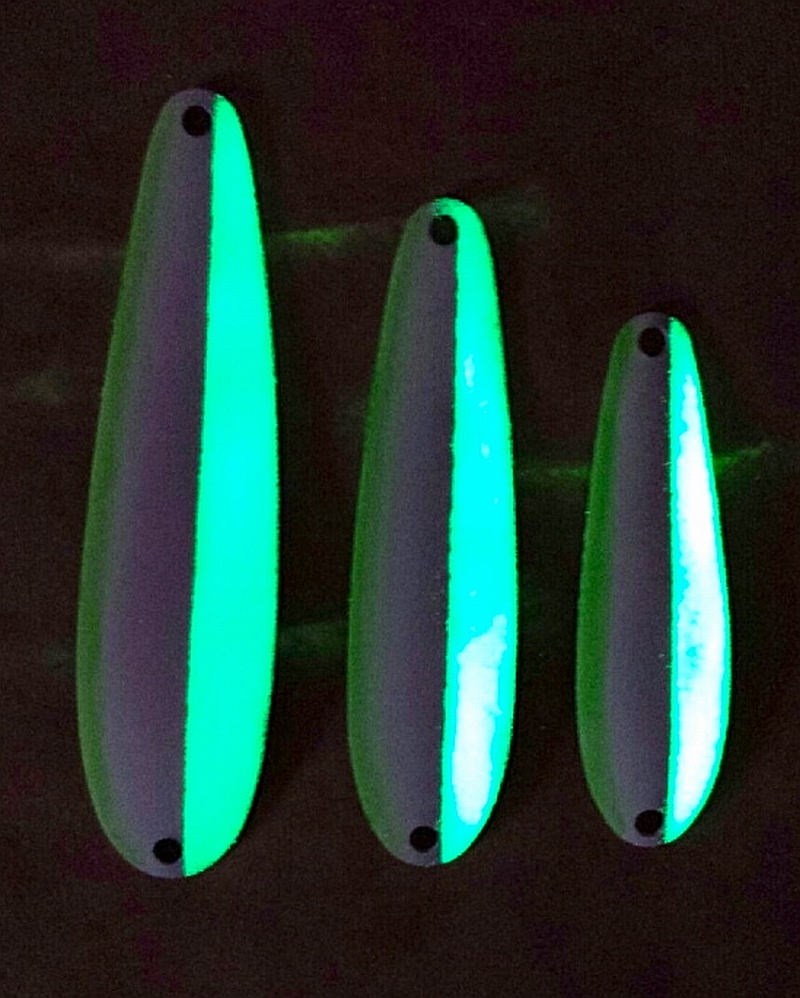
The Pesca Spoons really glow and work great for winter chinook when fishing deep and on the bottom.




